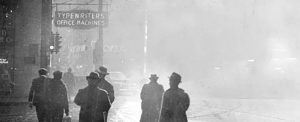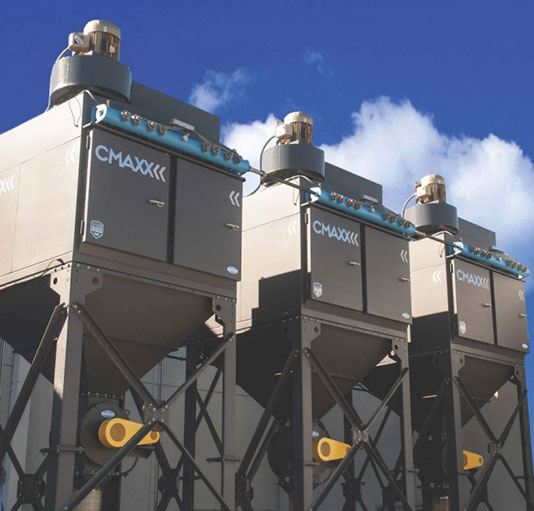The history of dust collection begins with a problem that needed to be solved.
It was the early 1800’s in Pittsburgh, PA. Sulfur and other fumes from burning bituminous coal covered the city with some of the worst smoke pollution in the country. Pittsburghers were used to constantly cleaning the black dust off everything, even inside their houses. By 1880, millions of tons of coal were being burned in the city each year, giving it some of the worst air quality in the United States.
People who grew up in the city in the early 1900’s report cleaning black dust and grime off their shoes and clothes, gray curtains that could never be kept white, and buildings and statues stained black. Workers from the steel mills came home covered with black coal dust. In the winter, gray snow fell over the city. Bituminous coal was plentiful in the area but is the dirtiest form of coal when burned.
Regulations were passed in Pittsburgh and other industrial cities, but without a suitable replacement, the factories and mills continued burning coal. Companies made some attempts to filter coal dust out of the air, but the amount of dust overwhelmed basic cloth filters. Simple cyclones, where air movement inside the chamber causes particles to drop out of the air flow, only captured large dust and didn’t restrict the flow of fine dust and smoke. Tubes or sheets of fabric became immediately coated with dust.

NEW DUST COLLECTION OPTIONS
It wasn’t until the 1920’s that inventors began to patent filtration systems to remove dust more effectively. These early dust collectors needed to be able to clean their filters to keep them from being overwhelmed with dust. In the early history of dust collectors, this cleaning worked by hanging filters from a frame that would periodically shake them to get rid of excess dust.
Shaker bags continued to be used for many years, but lack of efficiency and constant maintenance on the moving parts limited their usefulness. The biggest producers of dust included industries like foundries and steel mills, dealing with thick, heavy dust that shaker bag collectors struggled to handle.
In the mid-1900’s, environmental regulations became more common and major polluters came under pressure to clean up the massive amounts of dust they generated. Shaker bags and basic fabric filters could not handle the task. Pittsburgh, famous for its steel mills and still burning massive amounts of dirty bituminous coal from nearby mines, badly needed a new method of dust collection.
Reverse air baghouses were invented around this time, shortly followed by pulse jet baghouses. These provided tremendous improvements in dust collection by setting up an arrangement of filtration bags that could be cleaned by fans or compressed air pulses instead of shaking. These methods kept the bags cleaner and increased the efficiency of the filters. These types of baghouses came into regular use in the 1950’s and 1960’s, but there were still not very many requirements for companies to use them.
The invention of baghouses brought a new era in the history of dust collection. Both types of baghouses are still in use today, and they continue to work well. They are especially useful in applications with high temperatures and high humidity. Bags are now made of a wide variety of materials specialized for different needs. They are still workhorses of the dust collection industry.
A NEW ERA OF REGULATIONS
In the 1970’s and 1980’s, increases in regulations required companies to work harder to clean up dust, fume, and chemical emissions. Cartridge dust collectors provided a smaller profile with highly efficient pleated filters that offered a larger surface area for filtration. These collectors took advantage of a pulse jet cleaning system like the one used on some baghouses. Cartridge collectors became popular for their smaller size and the ease of changing filters compared to baghouses. They are used on many dust applications, especially those producing very fine dust and fumes.
With increasing regulations on hazardous material emissions, filters like HEPA (High Efficiency Particulate Arrestor) became more common. These filters are extremely efficient but will also become quickly overloaded in any heavy use setting. Common uses include hospital, pharmaceutical, and food processing clean rooms. In the history of dust collection in industry, they have become useful as after-filters for applications with very toxic materials like lead dust, capturing anything that gets past the regular filters.
Industries that need to control chemical air pollution may use options such as wet scrubbers or electrostatic precipitators. Wet scrubbers use water or other liquids to stick to chemicals in the air flow and cause them to settle out of the air. Wet scrubbers are much higher maintenance than dry dust collection systems, but they may be necessary for chemical contaminants. Electrostatic precipitators use high voltage direct current to give particles an electric charge, causing them to stick to electrodes in the collector.
These high-tech entries into the history of dust collection are useful for specific applications. Dry dust collectors like cartridges and baghouses will not usually work for mist or harsh chemicals. Wet scrubbers are used when the air contains either a gas or gas mixed with particles. Electrostatic precipitators are often used in coal and oil power plants and in refineries. These types of systems work best when the electrical conductivity and resistance of the particles stays consistent.

FROM THE HISTORY OF DUST COLLECTION TO THE FUTURE
In cities like Pittsburgh with a long history of dust collection issues, every possible type of air pollution control has been employed to make the city clean and healthy. Pittsburgh has traded most of its coal-burning steel manufacturing for newer, cleaner industries. It has been rated as one of the country’s most livable cities by many publications. Technology, research, and healthcare have become dominant industries, but the legacy of the city’s heavy industrial days remains with plenty of factories still in operation. Behind or off to the side of many of these factories, you’ll see a dust collector at work, helping Pittsburgh keep moving away from the grime and dust of its history.
Companies that manufacture dust collection systems are concerned with air quality. They are also concerned with safety. The industry keeps making new innovations that prevent people from being injured by combustible dust fires or explosions. New dust collectors like the CMAXX and BRF baghouse are safer and more efficient than ever before.


